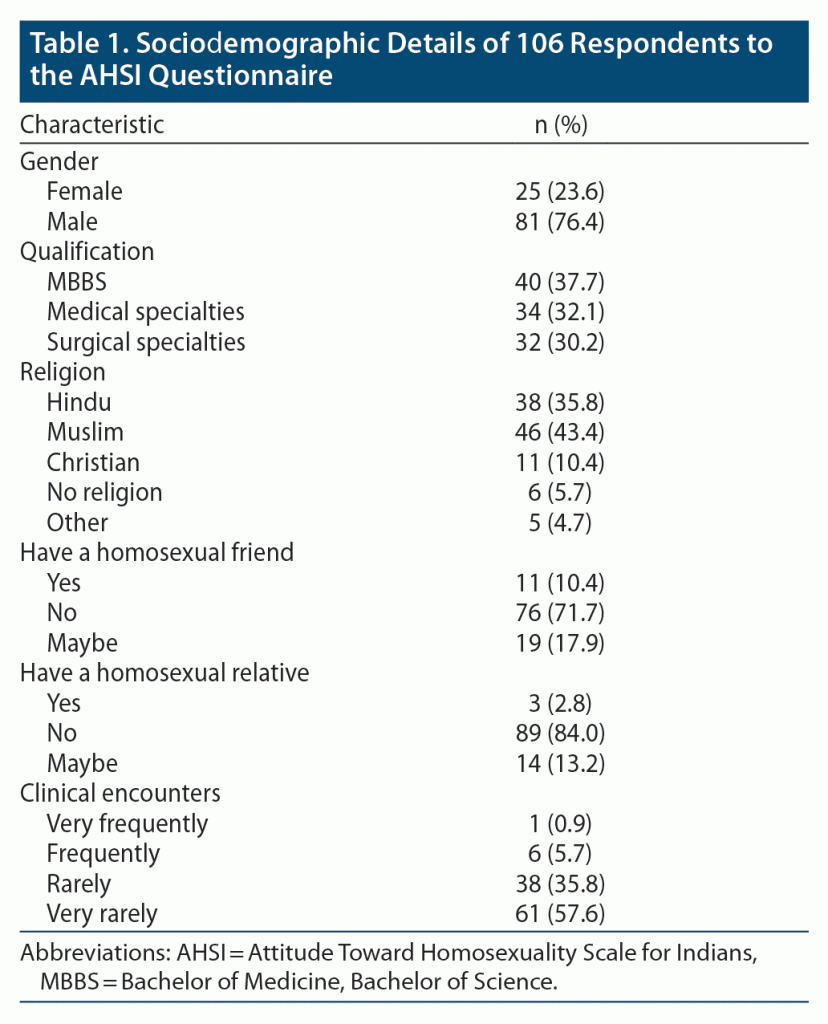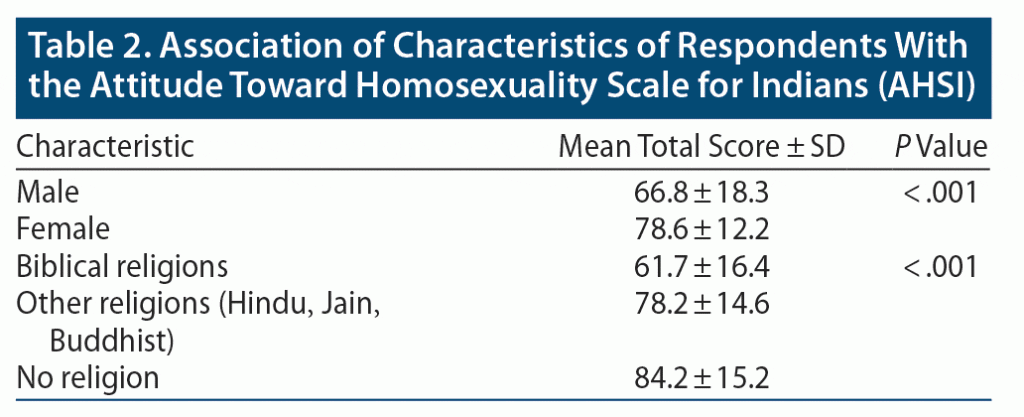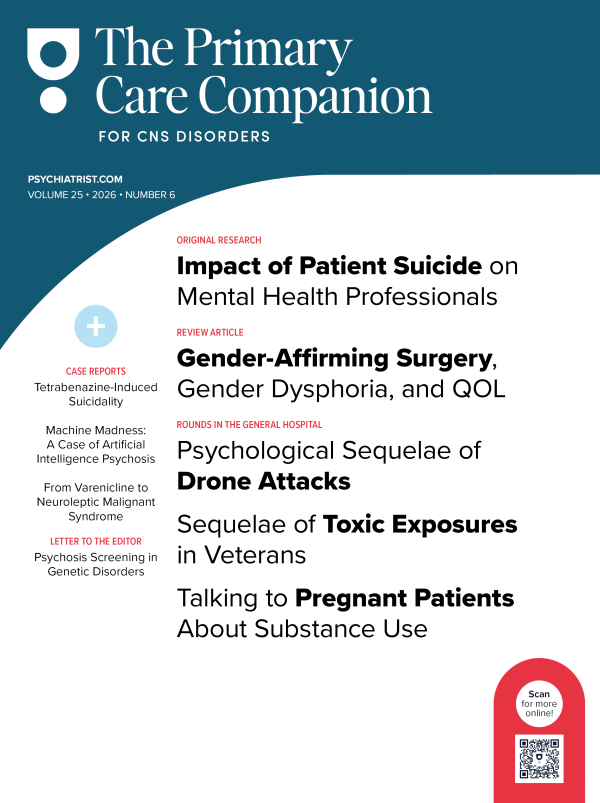ABSTRACT
Objective: To examine the attitudes among practicing physicians of various specialties toward homosexuality and its association with participants’ religious affiliations in India.
Methods: A cross-sectional descriptive study was conducted among physicians about their attitudes toward homosexuality between December 2018 and January 2019. Participants completed a survey anonymously in hardcopy form or online. The survey was developed based on the Attitude Toward Homosexuality Scale for Indians (AHSI). A higher AHSI score indicates less homonegativity. It was modified by adding demographic details, career status, and personal experience with homosexual individuals.
Results: The study results showed that among 106 respondents, 81 were men with a mean (SD) age of 32.2 (7.3) years. Of the participants, 40 (37.7%) were MBBS graduates with no specialization, while 34 (32.1%) and 32 (30.2%) respondents were from medical and surgical specialties, respectively. The majority of the respondents were Muslim (43.4%), followed by Hindu (35.8%), Christian (10.4%), those not conforming to any religion (5.7%), and other religions (4.7%). The mean ± SD total score on the AHSI was 69.6 ± 17.7, which was higher than the mean neutral score of 60. The AHSI total score was significantly higher among women (P < .001). The total AHSI score was highest among the no religion category followed by Hindus, with the lowest for biblical religions; the difference was statistically significant (P < .001). No significant difference was seen between Muslims and Christians.
Conclusions: This study showed an overall positive attitude among the respondents toward homosexuality; however, those belonging to Abrahamic religions, especially Muslims, had more negative attitudes. The results highlight the need for antistigma campaigns and educational interventions targeting the physician population of India to reduce negative attitudes toward homosexuality and improve their knowledge of this topic.
Prim Care Companion CNS Disord 2023;25(1):21m03047
To cite: Hafi B, Uvais NA, Eliyas SK, et al. Influence of religious affiliations on attitudes toward homosexuality among physicians: a cross-sectional study from India. Prim Care Companion CNS Disord. 2023;25(1):21m03047.
To share: https://doi.org/10.4088/PCC.21m03047
© 2023 Physicians Postgraduate Press, Inc.
aDepartment of Dermatology and Sexology, Iqraa International Hospital and Research Centre, Calicut, Kerala, India
bDepartment of Psychiatry, Iqraa International Hospital and Research Centre, Calicut, Kerala, India
cDepartment of Preventive and Social Medicine, Jawaharlal Institute of Postgraduate Medical Education and Research, Puducherry, India
dDepartment of Nephrology, Iqraa International Hospital and Research Centre, Kozhikode, Kerala, India
eDepartment of Medicine, Iqraa International Hospital and Research Centre, Calicut, Kerala, India
*Corresponding author: N. A. Uvais, MBBS, DPM, Iqraa International Hospital and Research Centre, Calicut, Kerala, India ([email protected]).
Negative attitudes and stigma regarding homosexuality have been well documented in multiple population studies.1,2 Homophobia is defined as an irrational fear or dislike of homosexuals, while homonegativity includes negative attitudes, values, and beliefs of the heterosexual majority toward homosexual couples, along with the negative reactions toward them.3 Such homonegative attitudes have been found among medical students and practicing physicians, and stigma-associated attitudes have been shown to predict behavioral intention to discriminate.3–5 Stigma also can lead to detrimental effects on both health care access and quality among this population, resulting in health disparities.6
India is a traditional multicultural, diversified, and integrated society. Most of the religious and cultural communities in India believe that marriage is a heterosexual institution. Prejudice against homosexuality is part of many cultures, incorporated into most religions, and is a source of conflict in Indian society, which is highlighted by the antihomosexual attitudes of many religious and community leaders.7 A study8 revealed that Indian society, by and large, disapproves of homosexuality and justifies it as a criminal offense even when adults engage in private. Moreover, this study8 also showed that only 10% of the Indian population are in favor of social and legal recognition of homosexuality. Furthermore, the legal status of homosexuals in India has also undergone dramatic changes during the past 10 years. Section 377 of the Indian Penal Code (1860) relates to unnatural offenses and includes homosexuality within its domain, and it made homosexuality illegal with life imprisonment or imprisonment for 10 years with a fine.9 However, in 2009, the Delhi High Court revoked Section 377 of the Indian Penal Code, stating that it violated the fundamental right of life and liberty and the right to equality as guaranteed in the Constitution.9 But, this verdict was overturned by the Supreme Court of India in December 2013.10 Recently, the Supreme Court declared that consensual sex between adults would no longer be a crime under Section 377 of the Indian Penal Code.10
Past studies have consistently reported that religious affiliation significantly influences attitudes toward homosexuality in the general population as well as within the medical fraternity. In a study4 from the United Kingdom, the participants (general practitioners) agreed that their religious views were very important in molding their attitudes toward homosexual men. Furthermore, another study11 from Serbia found that religious participants showed a greater tendency toward negative attitudes regarding homosexuality.
With the recent legal developments within the Indian context, it is important to study the attitudes of practicing physicians toward homosexuality, as patients may disclose their sexual orientation now more freely and without fear, and negative attitudes can damage the quality of health care for homosexual patients. It is also important to examine the factors influencing their attitudes toward homosexuality, especially regarding religious affiliation. Hence, the present study assessed the influence of religious affiliations on attitudes toward homosexuality among practicing physicians of various specialties in India.
METHODS
A cross-sectional descriptive study was conducted among physicians about their attitudes toward homosexuality. The questionnaire was created based on the Attitude Toward Homosexuality Scale for Indians (AHSI).12 The scale was modified by adding demographic details, career status, and personal experience with homosexual individuals. Both a hardcopy form and an online survey in a Google form format were created. The sampling population was physicians who were natives of Kerala, India. The sample was selected using a purposive sampling technique by directly contacting practicing physicians working in various specialties and a snowball sampling technique by asking the participants to share the Google form link with their peers through messages or e-mail.
Measures
The study instrument was a questionnaire consisting of 2 parts. The first part contained questions regarding sociodemographic data about the participants (ie, gender, age, year of graduation, specialty, religious beliefs, any homosexual friends, any homosexual relatives, and clinical encounter with homosexual patients).
The second part consisted of having participants complete the AHSI.12 The AHSI contains 20 items in which participants respond to each item on a 5-point Likert-type scale (1 = strongly disagree and 5 = strongly agree). Ten items are reverse scored, so that a higher score indicates more positive attitudes toward homosexuality. Scores could thus range from 20 to 100. The scale was validated in the Indian setting and showed an internal consistency reliability of Cronbach α = 0.97.12 Regarding reliability and validity, the AHSI showed a satisfactory split-half reliability coefficient of 0.84.
Procedure
This research was approved by the Institute Ethics Committee. The study was conducted between December 2018 and January 2019. Participants completed the surveys anonymously in hardcopy form or online. They gave their consent to participate in the research after reading a brief description of the study and the consent form attached to the survey. After agreeing to participate in the research, the participants filled out a sociodemographic questionnaire and the questionnaire regarding their attitudes toward homosexuality. The time necessary to complete the questionnaires was estimated to be 20 minutes. Statistical analysis was conducted using SPSS version 21 for windows.
RESULTS
A total of 109 responses were collected, of which 3 were excluded due to incomplete responses. Among 106 respondents, 81 were men. The mean (SD) age was 32.2 (7.3) years. The median (interquartile range) duration since graduation was 6 (3–10) years. Of the participants (Table 1), 40 (37.7%) were MBBS graduates with no specialization, while 34 (32.1%) and 32 (30.2%) respondents were from medical and surgical specialties, respectively. Most respondents were Muslim (43.4%), followed by Hindu (35.8%), Christian (10.4%), those not conforming to any religion (5.7%), and other religions (4.7%). Muslims and Christians were grouped together considering their Abrahamic lineage and similar concepts about homosexuality, sharing a story of Lot who was sent to the cities of Sodom and Gomorrah as a prophet to warn people against the practice. Similarly, Hindus and other religions (Jains, Osho, Buddhist) were grouped together for analytic purposes given their similar Eastern origin.
Of the participants, 11 (10.4%) reported having a homosexual friend, while 17.9% (n = 19) were unsure and 71.7% (n = 76) answered no. Only 2.8% (n = 3) of respondents reported having a homosexual relative, while 13.2% (n = 14) were unsure and 84.0% (n = 89) answered no. Only a single respondent reported seeing homosexual patients very frequently, while 57.6% (n = 61) reported seeing them very rarely (Table 1).
The mean ± SD total score on the AHSI was 69.6 ± 17.7, which was higher than the mean neutral score of 60. The mean ± SD total score was higher among women (78.6 ± 12.2) than men (66.8 ± 18.3), and an unpaired t test showed the difference was statistically significant (P < .001, Table 2). This result suggests less homophobia among females. The correlation analysis showed no significant difference in AHSI score with change in age (P = .381) or years after graduation (P = .401).
One-way analysis of variance (ANOVA) showed no difference in scores between participants with different specializations (P = .509). Mean ± SD total scores of participants who responded yes, no, or maybe for the question on having a homosexual relative were 60.3 ± 14.7, 67.6 ± 17.6, and 84.4 ± 11.5, respectively, but were not significant based on ANOVA. Status of having a homosexual friend as well as encountering homosexuals in clinical practice showed no significant differences.
The mean ± SD total score was highest among the no religion category (84.2 ± 15.2), followed by other religions (Hindu, Jain, Osho, Buddhist) (78.2 ± 14.6) and biblical religions (61.7 ± 16.4) (Table 2). One-way ANOVA showed that these differences between religions were statistically significant (P < .001). Post hoc analysis was conducted using a Bonferroni test and showed significant differences between Muslims and Hindus (P < .001), Muslims and other religions (P = .008), and Muslims and no religion (P = .003). No significant difference was seen between Muslims and Christians. When religions were regrouped to biblical, non-biblical, and no religion, significant differences were seen between participants of biblical religions and Hinduism (P < .001) and between participants of biblical religions and those who followed no religion (P = .008). No significant difference was noted between Hindus and participants following no religion (P = 1.000).
The multivariate regression analysis with change of gender to female and adjusting for religion showed an increase in total score of 8.29 points, and the shift was statistically significant (P = .022). Gender-adjusted regression analysis of religion showed a decrease of 22.18 points when no religion was changed to biblical religions, which was significant (P = .002).
DISCUSSION
The current study is the first in India, to our knowledge, that provides information on the attitudes of practicing physicians from various specialties toward homosexuality. Our results showed overall positive attitudes among the study participants toward homosexuality, as the mean total AHSI score was higher than the neutral score. To date, few attempts have been made to explore attitudes of practicing physicians toward homosexuality. Unlike our study findings, a survey-based cross-sectional study13 from India revealed that attitudes toward homosexuality among psychiatrists in India appear to be neutral. Another study14 exploring attitudes of medical students and interns toward homosexuality in the Indian context found that they endorsed a neutral stance. These inconsistencies could be due to differences in the geographic and cultural backgrounds of the respondents and in the instruments used across studies.
There are few studies from Western countries exploring the attitudes of physicians toward homosexuality. A comparative study4 conducted in the Midlands region of the United Kingdom between psychiatrists and general practitioners regarding physicians’ attitudes toward male homosexuality showed that general practitioners tended to be less liberal in their attitudes and more likely to believe in stereotypes compared to psychiatrists. Our study results failed to show any significant difference in attitudes toward homosexuality across various specialties including general practitioners. Another study15 compared attitudes of psychiatrists, general practitioners, homosexual physicians, and homosexual men toward male homosexuality. The results showed a significant difference in attitudes between all 4 groups, with the homosexual population being the most liberal and general practitioners the most conservative.15 Another study6 explored current physician attitudes toward homosexuality in the San Diego County medical community through an online survey. The results showed broad favorable shifts in Western societal attitudes toward homosexuality.6 Consistent with the findings of that study,6 our results also indicate a favorable shift in societal attitudes toward homosexuality, at least among the physician community.
The physician-patient relationship plays a vital role in improving the health of individuals. Homophobia among health professionals may complicate the doctor-patient relationship, therapeutic alliance, and treatment of homosexual individuals who often avoid routine medical care for fear of being discriminated against or stigmatized. Homonegative attitudes among practicing physicians and stigma-associated attitudes of physicians predict behavioral intention to discriminate, which can lead to detrimental effects on both health care access and quality among the homosexual population, resulting in health disparities.5,6
Our results also showed significantly positive attitudes toward homosexuality among females, which is consistent with previous studies from other countries. The US study6 exploring physician attitudes toward homosexuality in the San Diego County medical community found that male gender was a consistent predictor of greater sexual orientation stigma. A study14 exploring medical students’ and interns’ attitudes toward homosexuality in the Indian context also found that females had more positive attitudes toward homosexuals. Another study3 exploring attitudes toward homosexuality among medical students in Zagreb found that female students showed more positive attitudes than their male peers toward homosexuality. A similar study11 conducted among physicians and students in Belgrade revealed that males had a greater tendency to show negative attitudes compared to females. However, an Indian study13 exploring attitudes toward homosexuality among psychiatrists failed to show any significant difference across genders. And, in a Nigerian study exploring attitudes toward homosexuality among students in their final year of medical school, a higher proportion of female students had more negative attitudes toward homosexuals compared to students who had a homosexual friend.16 The reason for more positive homophobic attitudes among females in our study is unclear. However, it can be argued that because females are not subject to the same heteronormative and patriarchal social pressures as men, they may have less homophobic attitudes.3 Another explanation may be that women are generally more empathetic and thus express greater concern for the well-being of others compared to men.17
Past studies6,16,18 also found other characteristics associated with negative attitudes toward homosexuality such as earlier year of medical school graduation, students younger than age 25 years, heterosexual orientation, and participants who did not have a homosexual friend. However, our study failed to show any significant association between attitude toward homosexuality and age, year of graduation, having homosexual friends, and frequency of clinical encounters with homosexual patients.
Our study showed a significant difference in attitudes toward homosexuality across various religious groups, with respondents belonging to no religious category having more significantly positive attitudes followed by respondents belonging to the Hindu religion. Christian and Muslim respondents showed similar but significantly negative attitudes compared to other religious groups. The negative association of religiosity and attitude toward homosexuality is a consistent finding in the literature. The study4 conducted in the Midlands region of the United Kingdom found that general practitioners with negative attitudes toward homosexuality agreed that their religious views were very important in molding these attitudes. Another study11 conducted at a school of medicine in Belgrade also found that religious participants had a greater tendency to show negative attitudes.
Across the world, personal religious beliefs and affiliation are typically seen as powerful predictors of negative attitudes toward homosexuality. Most religions, especially Abrahamic religions, tend to categorize behaviors associated with homosexuality as “unnatural,” ‘”ungodly,” and “impure.”19 A meta-analysis of religiosity and attitudes toward homosexuality showed that most forms of religiosity—fundamentalism, religious service attendance, orthodoxy, self-rated religiosity, and intrinsic orientation—are related in varying degrees to negative attitudes toward homosexuality.20 However, the least traditional form of religiosity—quest orientation—was related to positive attitudes toward homosexuality.20 The authors20 also highlighted that beliefs about the nature of homosexuality, perceived threat to important group values, and right-wing authoritarianism mediate attitudes toward homosexuality among religious individuals. Public opinion research has also repeatedly shown that religious individuals report more prejudice against homosexuality compared to their nonreligious counterparts.21 Research conducted among the 3 monotheistic religions (Christianity, Islam, and Judaism) has shown that the stronger people adhere to their faith and the more strictly they are guided by the rules of conviction, the more prejudiced they are toward homosexuals.22
Our data also showed that among the various religious affiliations of the respondents, Muslims had significantly higher negative attitudes toward homosexuality. Similar to our results, a population study21 from Belgium revealed that young Muslims (strong and medium believers) are the most averse/hostile to homosexuality. Another study22 also found that Muslims appeared less likely to approve of homosexuality compared to Catholics, Orthodox Christians, Jews, Hindus, Buddhists, and people with no religion. This negative attitude toward homosexuality might be stemming from collectivism and traditional gender roles, which are the core values of Muslim society. Moreover, when young Muslims are socialized in these traditional gender norms, homosexuality becomes a violation of the accepted norm.23 Furthermore, another study24 exploring conservative social values among non–Judeo-Christian groups found that Muslims had more conservative social values than Catholics and Protestants.
To our knowledge, this is the first study to use a validated instrument in the Indian setting, which is the major strength of our study. Our study also has some limitations. Although we received over 100 responses, the nonrespondents may have more negative attitudes. Moreover, some of the respondents might have been concerned about the researchers linking their survey with their identity and thus gave more socially desirable answers. Furthermore, the study was conducted among physicians with a self-report questionnaire, which could also result in some biased answers. Therefore, our findings cannot be generalized to the whole physician population of India. It would also be desirable to have qualitative data to supplement the quantitative findings.
CONCLUSION
The current study, to our knowledge, is the only one of its kind conducted within the Indian context among practicing physicians belonging to various specialties. Our study showed overall positive attitudes among the studied population toward homosexuality. Most of the study findings such as more positive attitudes among female participants and more negative attitudes among respondents belonging to Abrahamic religions, especially Muslims, are consistent with the existing data. Research has shown that homonegative attitudes among practicing physicians and stigma-associated attitudes of physicians predict behavioral intention to discriminate, which can lead to detrimental effects on both health care access and quality among the homosexual population, resulting in health disparities. Hence, our study results highlight the urgent need for antistigma campaigns and educational interventions targeting the physician population of India to reduce negative attitudes toward homosexuality and improve their knowledge of this topic.
Submitted: November 17, 2021; accepted June 12, 2022.
Published online: February 9, 2023.
Relevant financial relationships: None.
Funding/support: None.
CLINICAL POINTS
- Homonegative attitudes among physicians lead to discrimination and health disparities.
- More positive attitudes toward homosexuality were found among females, while respondents belonging to Abrahamic religions, especially Muslims, had more negative attitudes.
- There is a need for antistigma campaigns and educational interventions targeting the physician population in India to reduce negative homosexual attitudes.
References (24)

- Kelley J. Attitudes towards homosexuality in 29 nations. Australian Social Monitor. 2001;4(1):15–22.
- Pew Research Center. The Global Divide on Homosexuality: Greater Acceptance in More Secular and Affluent Countries. Accessed January 20, 2019. www.pewglobal.org/2013/06/04/the-global-divide-on-homosexuality/
- Grabovać I, Abramović M, Komlenović G, et al. Attitudes towards and knowledge about homosexuality among medical students in Zagreb. Coll Antropol. 2014;38(1):39–45. PubMed
- Bhugra D. Doctors’ attitudes to male homosexuality: a survey. J Sex Marital Ther. 1990;5(2):167–174. CrossRef
- Vijay A, Earnshaw VA, Tee YC, et al. Factors associated with medical doctors’ intentions to discriminate against transgender patients in Kuala Lumpur, Malaysia. LGBT Health. 2018;5(1):61–68. PubMed CrossRef
- Marlin R, Kadakia A, Ethridge B, et al. Physician attitudes toward homosexuality and HIV: the PATHH-III Survey. LGBT Health. 2018;5(7):431–442. PubMed CrossRef
- Rao TS, Jacob KS. Homosexuality and India. Indian J Psychiatry. 2012;54(1):1–3. PubMed CrossRef
- Parasar A. Homosexuality in India: The Invisible Conflict. Jodhpur: A. Parasar; 2007.
- Delhi high court decriminalizes homosexuality. 2018. Accessed June 20, 2018. https://www.livemint.com/Politics/sl3bjL7PX8MzUeOhPGejyI/Delhi-high-court-decriminalizes-homosexuality.html
- Dutta PK. Supreme Court verdict on Section 377: Homosexuality back to the realm of morality. India. 2018. Accessed January 20, 2019. https://www.indiatoday.in/india/story/supreme-court-verdict-section-377-homosexuality-morality-1333344-2018-09-06
- Dunjić-Kostić B, Pantović M, Vuković V, et al. Knowledge: a possible tool in shaping medical professionals’ attitudes towards homosexuality. Psychiatr Danub. 2012;24(2):143–151. PubMed
- Ahuja KK. Development of Attitudes Toward Homosexuality Scale for Indians (AHSI). J Homosex. 2017;64(14):1978–1992. PubMed CrossRef
- Srikanth R, Pooja R, Meraj Q, et al. Attitudes towards homosexuality among psychiatrists in India: a survey-based cross-sectional study. Arch Psychiatry Psychother. 2016;3:32–39.
- Banwari G, Mistry K, Soni A, et al. Medical students and interns’ knowledge about and attitude towards homosexuality. J Postgrad Med. 2015;61(2):95–100. PubMed CrossRef
- Bhugra D, King M. Controlled comparison of attitudes of psychiatrists, general practitioners, homosexual doctors and homosexual men to male homosexuality. J R Soc Med. 1989;82(10):603–605. PubMed CrossRef
- Adayonfo EO, Selo-Ojeme CO. Attitude of final year medical students of a Nigerian university towards homosexuality. Ann Biomed Sci. 2017;16:1.
- Beutel AM, Marini MM. Gender and values. Am Sociol Rev. 1995;60(3):436–448. CrossRef
- Matharu K, Kravitz RL, McMahon GT, et al. Medical students’ attitudes toward gay men. BMC Med Educ. 2012;12(1):71. PubMed CrossRef
- Yip A. Queering religious texts: an exploration of British non-heterosexual Christians’ and Muslims’ strategy of constructing sexuality affirming hermeneutics. Sociology. 2005;39(1):47–65. CrossRef
- Whitley BE Jr. Religiosity and attitudes toward lesbians and gay men: a meta-analysis. Int J Psychol Relig. 2009;19(1):21–38. CrossRef
- Roggemans L, Spruyt B, Droogenbroeck FV, et al. Religion and negative attitudes towards homosexuals: an analysis of urban young people and their attitudes towards homosexuality. Young. 2015;23(3):254–276. CrossRef
- Adamczyk A, Pitt C. Shaping attitudes about homosexuality: the role of religion and cultural context. Soc Sci Res. 2009;38(2):338–351. PubMed CrossRef
- Duck RJ, Hunsberger B. Religious orientation and prejudice: the role of religious proscription, right-wing. Int J Psychol Relig. 1999;9(3):157–179. CrossRef
- Yuchtman-Yaar E, Alkalay Y. Religious zones, economic development and modern value orientations: individual versus contextual effects. Soc Sci Res. 2007;36(2):789–807. CrossRef
Please sign in or purchase this PDF for $40.







